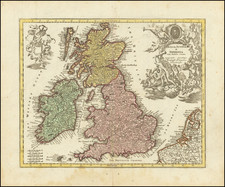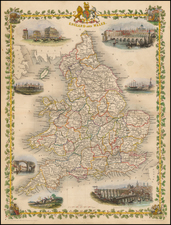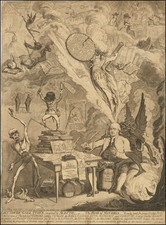A rare and attractive cover of a musical pamphlet illustrating a 'National Song' celebrating the greatest victories of Britain's Navy and Army.
This rheotrically powerful patriotic compostion was conceived to illustrate a song composed to encourage voluntary conscription in Britain's armed forces during the ongoing Crimean War (1853-1854).
The center of the piece featueres a roundel with the motto "England Expects Every Man to Do His Duty", the tradtional English precursor to the American recruitment motto "We Want You!". The compostion is surmounted by a wreath carried by angels containing the portraits of the era's greatest British military heroes, Lord Admiral Horatio Nelson (1758-1805) and Arthur Wellesley, the Duke of Wellington (1769-1852). Below, the scene is flanked by a Red Coat soldier (on the left), carrying an Army Ensign adorned with the greatest British army victories of the era (Waterloo, Talavera, etc.), while on the right side is a Royal Navy sailor bearing an ensign adorned with Britain's greatest sea victories of the era (Trafalgar, Cape St. Vincent, etc.). In the background are various ships and forms of ordinance. The entire scene illuminated in full by fine original hand-coloring.
This illustration was drafted by J. Brandard to make up the cover illustration of a musical booklet featuring the song Our Soldiers and Our Sailors, written by James Bellamy and composed by Charles W. Glover. It was sold by the prominent music publishing firm of Campbell, Ransford & Co. of 53 New Bond St., London.
It can be definitively dated by an advertisement that appears in the periodical Musical World, vol. 32 (1854), p.136. The mansucript inscription in the upper right corner actually reads "J. Hurst 1856", and not "1836", as it may first appear.
As a piece of ephemera the survival rate of such pamphlets of musical scores and their illustrated covers is very low, such that this illustration is very rare.









![[ English Historical Broadsheets ] A Table of All The Counties of England and Wales, To Which is added, A Chronology of the Kings of England (with) A Brief History of England, since the Time of Julius Caesar.](https://storage.googleapis.com/raremaps/img/small/103973.jpg)




![[Set of Four Allegorical Mezzotints of the Continents -- With a Mastodon!] America. Europa. Africa. Asia.](https://storage.googleapis.com/raremaps/img/small/56726.jpg)